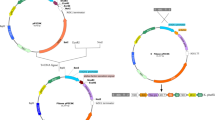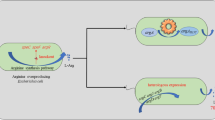Abstract
Sarcosine oxidase (SOX) was an important diagnostic enzyme in the renal function examination. An integrated strategy coupling codon and fermentation optimization was firstly proposed for improving SOX production from recombinant E. coli in 3-L fermentor. The expression suppression (gene phase) and poor balance between SOX expression and cell growth (fermentation phase) in the traditional SOX production were respectively improved by the multiple strategies. Based on the codon bias, the expression suppression was weakened via codon optimization and SOX activity reached 1,521 U/L. The induction toxicity was reduced with the optimal induction condition and SOX production increased to 4,015 U/L. Based on the kinetic analysis of μ x and μ p , a better balance between cell growth and expression was achieved by the two-stage pH-stat control strategy. The SOX activity was further improved to 8,490 U/L and fermentation cycle was also significantly shortened from 44 to 32 h. The substrate inhibition was weakened with a constant feeding fed-batch. With the assistance of integrated strategy, the activity and productivity reached 12,466 U/L and 389.6 U/(L h), respectively, or 3.1-fold and 4.3-fold of the uncontrolled fermentation. The strategy would be also useful in the industrial application of other similar enzymes.




Similar content being viewed by others
References
Andersen DC, Krummen L (2002) Recombinant protein expression for therapeutic applications. Curr Opin Biotechnol 13:117–123
Çalik P, Bilir E, Çalik G, Özdamar TH (2002) Influence of pH conditions on metabolic regulations in serine alkaline protease production by Bacillus licheniformis. Enzyme Microb Technol 31:685–697
Çalik P, Yilgör P, Demir AS (2006) Influence of controlled-pH and uncontrolled-pH operations on recombinant benzaldehyde lyase production by Escherichia coli. Enzyme Microb Technol 38:618–628
Chen XZ, Zhou L, Tian KM, Kumar A, Singh S, Prior AA, Wang ZX (2013) Metabolic engineering of Escherichia coli: a sustainable industrial platform for bio-based chemical production. Biotechnol Adv 31:1200–1223
Choi JH, Lee SY (2004) Secretory and extracellular production of recombinant proteins using Escherichia coli. Appl Microbiol Biotechnol 64:625–635
Choi JH, Keum KC, Lee SY (2006) Production of recombinant proteins by high cell density culture of Escherichia coli. Chem Eng Sci 61:876–885
Donovan RS, Robinson CW, Glick BR (1996) Optimizing inducer and culture conditions for expression of foreign proteins under the control of the lac promoter. J Ind Microbiol 16:145–154
Eiteman MA, Altman E (2006) Overcoming acetate in Escherichia coli recombinant protein fermentations. Trends Biotechnol 24:530–536
Gombert AK, Kilikian BV (1998) Recombinant gene expression in Escherichia coli cultivation using lactose as inducer. J Biotechnol 60:47–54
Goyal D, Sahni G, Sahoo DK (2009) Enhanced production of recombinant streptokinase in Escherichia coli using fed-batch culture. Bioresour Technol 100:4468–4474
Gu PF, Yang F, Su T, Li F, Li Y, Qi QS (2014) Construction of an l-serine producing Escherichia coli via metabolic engineering. J Ind Microbiol Biotechnol 41:1443–1450
Guo KP, Ma XH, Sun GQ, Zhao YH, Li X, Zhao WF, Ler K (2006) Expression and characterization of a thermostable sarcosine oxidase (SOX) from Bacillus sp. in Escherichia coli. Appl Microbiol Biotechnol 73:559–566
Jhamb K, Sahoo DK (2012) Production of soluble recombinant proteins in Escherichia coli: effects of process conditions and chaperone co-expression on cell growth and production of xylanase. Bioresour Technol 123:135–143
Kilikian BV, Suárez ID, Liria CW, Gombert AK (2000) Process strategies to improve heterologous protein production in Escherichia coli under lactose or IPTG induction. Process Biochem 35:1019–1025
Li YK, Li MJ, Zhang X, Yang P, Liang QF, Qi QS (2013) A novel whole-phase succinate fermentation strategy with high volumetric productivity in engineered Escherichia coli. Bioresour Technol 149:333–340
Li ZF, Su LQ, Wang L, Liu ZG, Gu ZB, Chen J, Wu J (2014) Novel insight into the secretory expression of recombinant enzymes in Escherichia coli. Process Biochem 49:599–603
Lim HK, Lee SU, Chung SI, Jung KH, Seo JH (2004) Induction of the T7 promoter using lactose for production of recombinant plasminogen kringle 1–3 in Escherichia coli. Appl Microbiol Biotechnol 14:225–230
Ma XQ, Su EZ, Zhu Y, Deng SW, Wei DZ (2013) High-level expression of glutaryl-7-aminocephalosporanic acidacylase from Pseudomonas diminuta NK703 in Escherichia coli by combined optimization strategies. J Biotechnol 168:607–615
Malakar P, Venkatesh KV (2012) Effect of substrate and IPTG concentrations on the burden to growth of Escherichia coli on glycerol due to the expression of Lac proteins. Appl Microbiol Biotechnol 93:2543–2549
Marbach A, Bettenbrock K (2012) Lac operon induction in Escherichia coli: Systematic comparison of IPTG and TMG induction and influence of the transacetylase LacA. J Biotechnol 157:82–88
Overton TW (2014) Recombinant protein production in bacterial hosts. Drug Discov Today 19:590–601
Pinsach J, Mas CD, López-Santín J (2008a) Induction strategies in fed-batch cultures for recombinant protein in Escherichia coli: application to rhamnulose 1-phosphate aldolase. Biochem Eng J 41:181–187
Pinsach J, Mas CD, López-Santín J, Striedner G, Bayer K (2008b) Influence of process temperature on recombinant enzyme activity in Escherichia coli fed-batch cultures. Enzyme Microb Technol 43:507–512
Sørensen HP, Mortensen KK (2005) Advanced genetic strategies for recombinant protein expression in Escherichia coli. J Biotechnol 115:113–128
Tong YJ, Xin Y, Yang HL, Zhang L, Tao XM, Xu H, Wang W (2013) Novel affinity purification of monomeric sarcosine oxidase expressed in Escherichia coli. J Sep Sci 36:3086–3092
Tong YJ, Xin Y, Yang HL, Zhang L, Wang W (2014) Efficient improvement on stability of sarcosine oxidase via poly-lysinemodification on enzyme surface. Int J Biol Macromol 67:140–146
Valipour E, Moosavi ML, Amani J, Nazarian S (2014) High level expression, purification and immunogenicity analysis of a protective recombinant protein against botulinum neurotoxin type E. World J Microbiol Biotechnol 30:1861–1867
Vincentelli R, Romier C (2013) Expression in Escherichia coli: becoming faster and more complex. Curr Opin Struct Biol 23:326–334
Yan GL, Du GC, Li Y, Chen J, Zhong JJ (2005) Enhancement of microbial transglutaminase production by Streptoverticillium mobaraense: application of a two-stage agitation speed control strategy. Process Biochem 40:963–968
Yang MF, Li XF, Bu CY, Wang H, Shi GL, Yang XS, Hu Y, Wang XQ (2014) Pyruvate decarboxylase and alcohol dehydrogenase overexpression in Escherichia coli resulted in high ethanol production and rewired metabolic enzyme networks. World J Microbiol Biotechnol 30:2871–2883
Acknowledgments
This work was supported by a grant from the National Natural Science Foundation of China (Grant No. 21306064), Science and Technology Supporting Plan of Jiangsu Province (No. BE2010625 and BE2011625), Natural Science Foundation of Jiangsu Province (No. BK2012119), Innovation Projects Plan of Jiangsu Province (No. CXZZ12_0752), Doctor Candidate Foundation of Jiangnan University (JUDCF12013), Scientific Program of Jiangnan University (No. JUSRP11120), and 111 Project (No. 111-2-06).
Author information
Authors and Affiliations
Corresponding authors
Rights and permissions
About this article
Cite this article
Tong, Y., Yang, H., Xin, Y. et al. Novel integration strategy coupling codon and fermentation optimization for efficiently enhancing sarcosine oxidase (SOX) production in recombinant Escherichia coli . World J Microbiol Biotechnol 31, 707–716 (2015). https://doi.org/10.1007/s11274-014-1795-9
Received:
Accepted:
Published:
Issue Date:
DOI: https://doi.org/10.1007/s11274-014-1795-9




